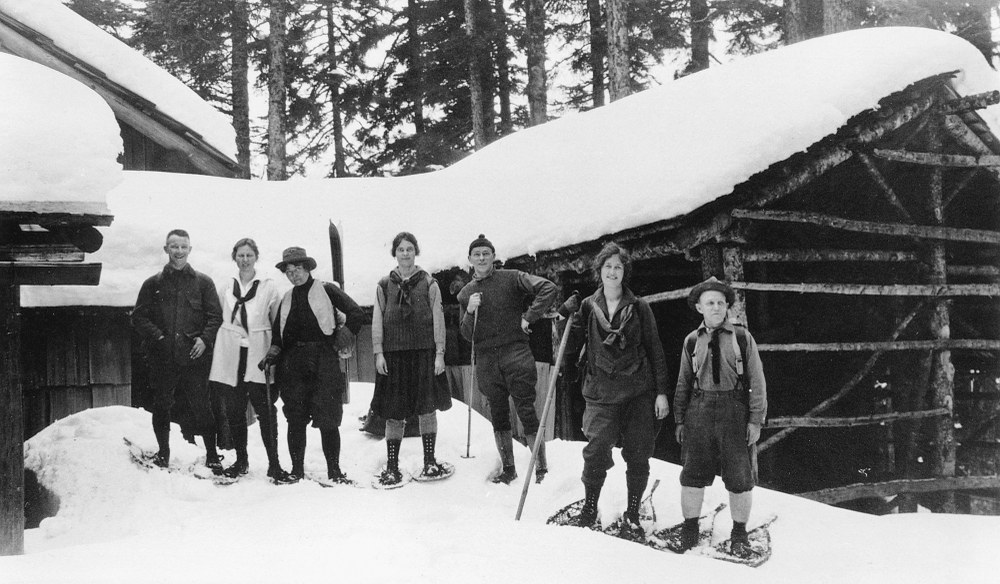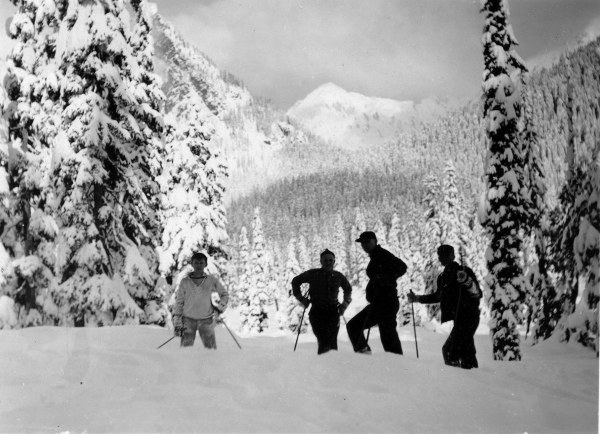
Skiers and snowboarders in Washington State are lucky to enjoy a wide range of opportunities to zip down the hill. You want the deepest snow? Head to Mt. Baker. Easy access from Seattle? Snoqualmie has you covered. Looking for something small and community-oriented? Visit Meany Lodge! With a range of options to choose from, Washingtonians have it pretty good. Over the past 100 years though, the ski map of Washington has changed dramatically. The Cascade and Olympic Mountains have been home to dozens of resorts, and the ones you see now are the few that remain. Of the current popular areas, few were present in the minds of skiers before the last few decades. Buckle your boots – we’re going for a trip to the hidden gems of yesteryear.
The Mountaineers at Lost Lake (1914-2006)
The original Mountaineers Snoqualmie Lodge served as an allseasons adventure hub for Mountaineers to climb, hike, and ski in the early 1900s. It was described as a beautiful, rustic, off-the-grid lodge, and Jim Kjeldsen wrote about it in detail in The Mountaineers: A History. “The original Snoqualmie Lodge was built on a knoll about a quarter-mile southwest of the lake. The structure was made almost entirely of materials found on site, including logs that were peeled, cedar that was turned into roof shakes, and stones for a huge fireplace.” The lodge was an important focal point in the early days of The Mountaineers, allowing members to develop their climbing and skiing skills and giving them access to Snoqualmie Pass before the highway was built. That all changed when the lodge burnt down in 1944, after a spark from the caretaker’s bonfire lit the highly-flammable cedar shakes on the roof. After the dust settled a new plot of land was purchased, this time chosen with skiing specifically in mind, and a new lodge was built. The Mountaineers enjoyed skiing, climbing, and other activities around the new Snoqualmie Lodge until it also tragically burned down in 2006. The Pacific Crest Trail now winds through the old property.
 Skiers at Snoqualmie Pass, 1938. Photo from the Don Sherwood Parks History Collection (Record Series 5801-01). courtesy of the Seattle Municipal Archives.
Skiers at Snoqualmie Pass, 1938. Photo from the Don Sherwood Parks History Collection (Record Series 5801-01). courtesy of the Seattle Municipal Archives.
First in the West (1921-1936)
The Cle Elum Ski Hill was best known for its status as the first ski hill west of Colorado. An immensely popular resort in the Snoqualmie Pass region, it attracted hundreds of skiers each winter weekend by the late 1920s, when organized skiing centered on jumping contests. Cle Elum Ski Hill featured a state-of-the-art ski jump and toboggan course, and hosted races and jumping competitions that attracted competitors from across the Northwest. All good things come to an end sadly, and competition with resorts closer to Seattle coupled with the steep slopes and lack of uphill assistance took business away from the small operation. The owners of the resort spent the early 1930s building new features and bigger jumps to try and attract crowds and competitions, but it was outshined by the newer, fancier Snoqualmie Pass resorts. As downhill and slalom skiing became the premier competitive arenas of the sport, the jumping and crosscountry features of the Cle Elum Ski Hill became antiquated. The hill closed permanently in 1936.
A skier’s paradise (1937-1970s)
Mount Rainier National Park‘s Paradise is a winter recreationist’s heaven, as its name suggests. If you’re willing to slap skins on your skis, strap into snowshoes, or explore the sledding area on foot, endless fun is available – albeit with a bit of work. But skiing at Paradise hasn’t always been solely humanpowered. Eighty years ago a rope tow was installed, and Olympic tryouts were held there in 1935 (rumor has it that eager Mountaineers members also participated, but performed poorly in relation to the superior techniques of the rest of the world). Unlike other ski areas’ machinery that stayed put over the summer, the equipment installed at Paradise was required to be mobile. Regardless of the popularity of the area in winter, the park stood by its rule that anything set up was taken down for the summer to protect the scenic views. Paradise stayed popular, especially post-World War II, when skitrained soldiers came to enjoy their new skills upon returning home from war. The demand for lifts kept growing, but the park stood by its rule. This led to the idea for the Forest Service to lease nearby land, creating the Crystal Mountain and White Pass ski areas. Their popularity and modern amenities shrunk the crowds on the Paradise rope tow, eventually allowing for its dismantling in the mid-1970s.
Above the treeline (1951-1978)
Though you may know it for its easy access, beautiful valley views, and popularity as a Western Cascades hiking destination, Mount Pilchuck held a resort on its slopes for nearly thirty years. The base of the resort sat at about 3,100 feet, with lifts running from 2,600 to 4,300 feet near the peak. You can thank the ski resort for the easy road access high into the mountain’s current hiking trails. The first rope tow was installed in 1951, followed by a few more throughout the 1950s. In 1963 the ski area gained its upper chairlift, and the snow was so deep that year the lifts needed trenches dug for them to run up the mountain. In 1967, a lower chairlift was added. Mount Pilchuck is still known for its great views of the valley below, and on a sunny day at the resort the panoramic views were said to be incredible. But the resort sat upon a mix of federal and state land, making management and permitting for the area a logistical nightmare. Eventually, the complicated setting, combined with off-and-on snow years (it was prone to rain due to its lower elevation) made it hard for the resort operators to plan and expand long-term. The 1978 season was the resort’s last, and a couple years later the lifts were purchased and removed from the mountain by Crystal Mountain Ski Resort.
In the trees (1969-1974)
The cheerily-named Yodelin may be familiar to backcountry and Nordic skiers. Located in the Stevens Pass/Highway 2 area, it’s a popular touring spot filled with beautiful, gladed runs, with small structures hinting at the area’s skiing history. In the 1960s and 70s, it was a popular resort in competition with today’s well-known Stevens Pass Ski Resort. Just a few miles east of where Stevens Pass sits today, Yodelin was surrounded by cabins where families could stay and enjoy the winter resort experience. It was quaint, without many of the amenities of the larger resorts, but was popular and had good snow. Tragically, in 1971 an incredible storm dumped wet, heavy snow onto the mountain, resulting in a massive avalanche that crushed two cabins and killed four people. The ski area would never truly recover from the disaster, and that, paired with competition with the larger and more popular Stevens Pass, resulted in Yodelin closing its doors in 1974. It sold some of its equipment to its growing neighbor and the area became the backcountry favorite we know today.
This article originally appeared in our Winter 2020 issue of Mountaineer Magazine. To view the original article in magazine form and read more stories from our publication, visit our magazine archive.
Add a comment
Log in to add comments.I tell people all the time -- usually in association with trips into the Mountain Loop/Monte Cristo area -- that there used to be a ski area at Pilchuck. I'm accustomed to strange looks in return...! Great article!
 Trevor Dickie
Trevor Dickie